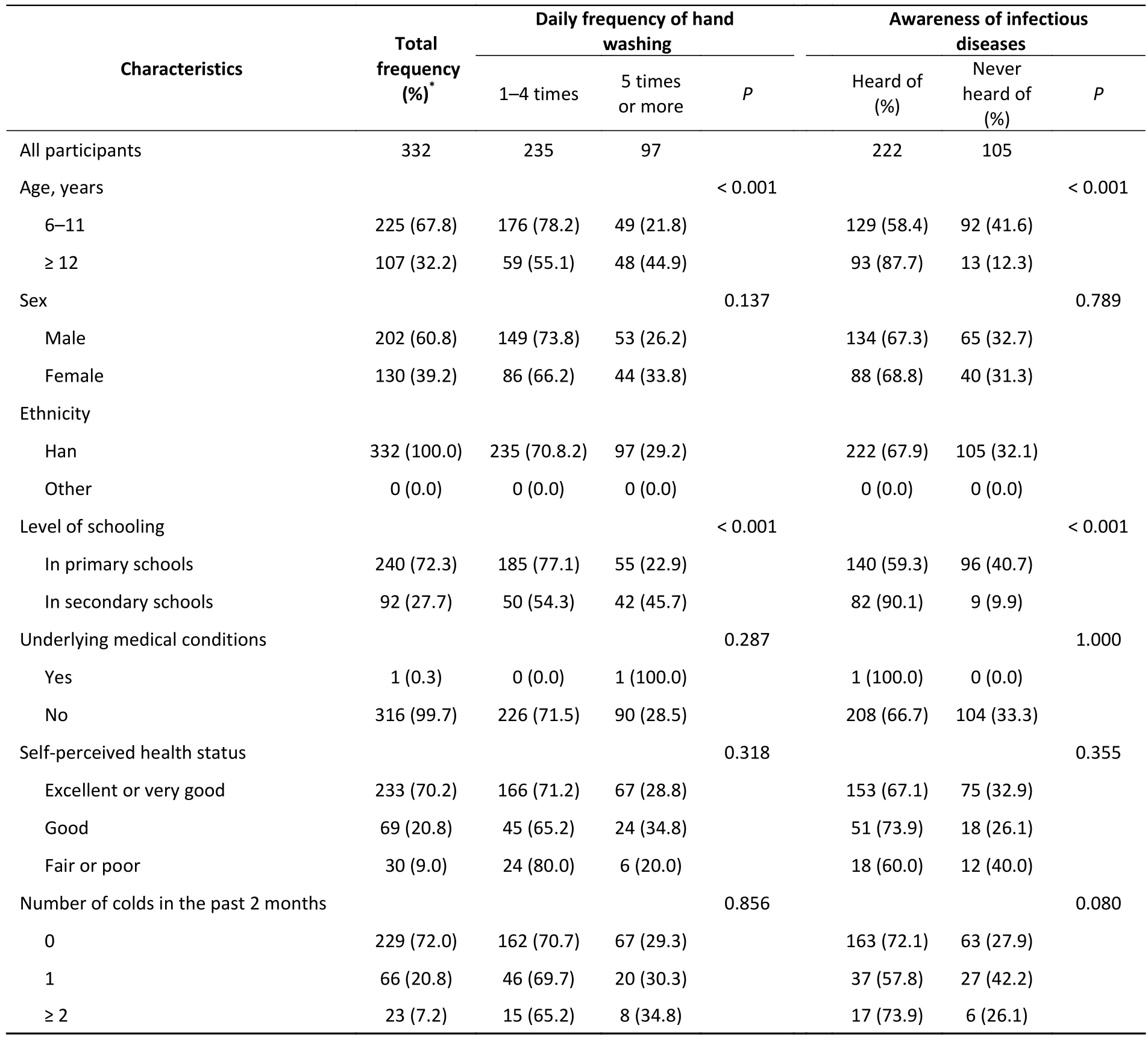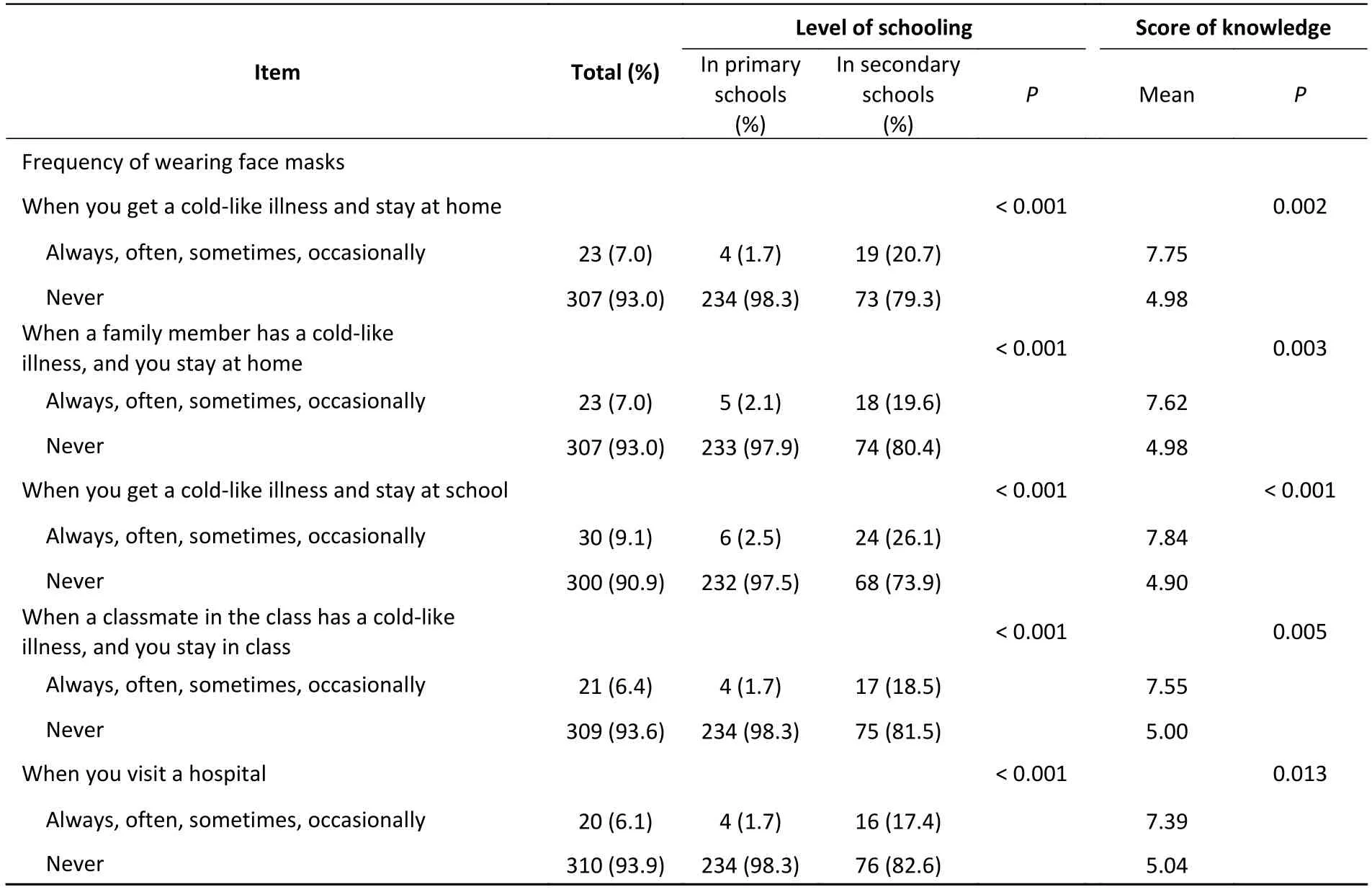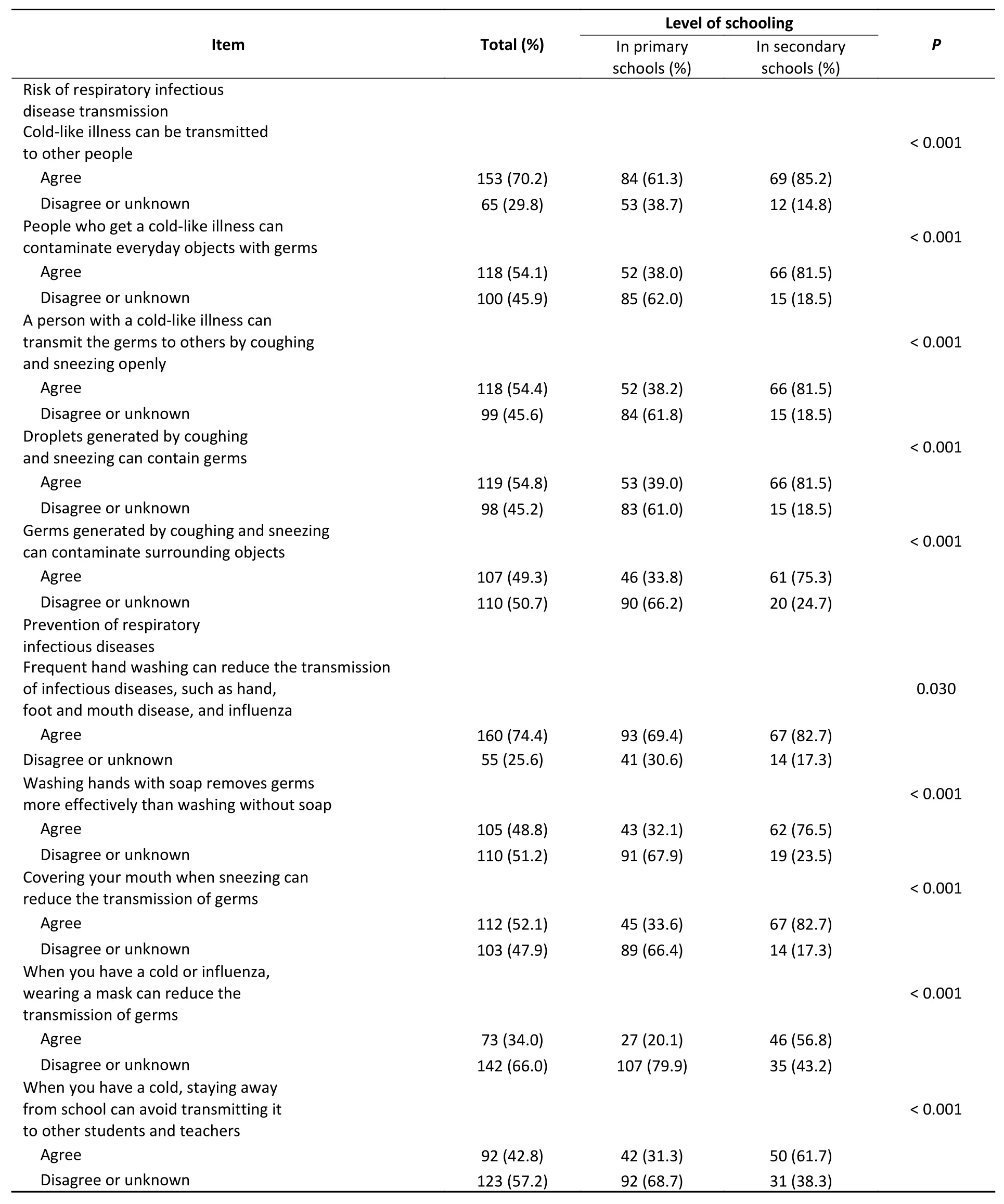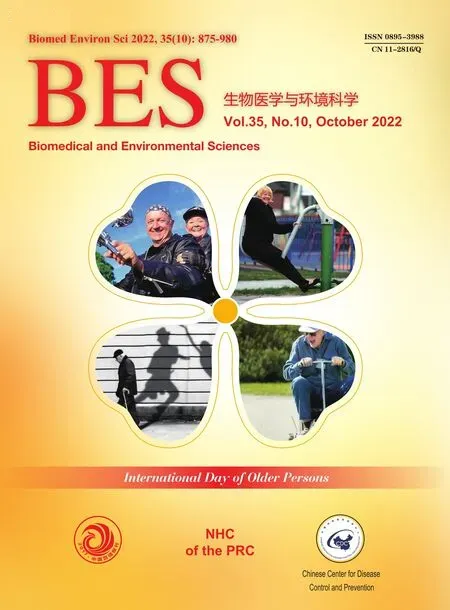Knowledge and Use of Personal Protective Measures for Mitigating Acute Respiratory lnfections in Children 6–16 Years of Age in Rural Communities of Macheng City, Hubei, China*
2022-11-07CHENYueZHANJianBoDONGShaoBoLUJianGUOJunFengFANJinSongGEJingLINXiaoJingLANYuQINKunHUBingZHOUJianFangandXUCuiLing
CHEN Yue, ZHAN Jian Bo, DONG Shao Bo, LU Jian, GUO Jun Feng, FAN Jin Song, GE Jing,LIN Xiao Jing, LAN Yu, QIN Kun, HU Bing, ZHOU Jian Fang,#, and XU Cui Ling,#
Acute respiratory infections are the most common illnesses experienced by people of all ages worldwide.Previous epidemiologic studies have shown that viruses cause most of these acute respiratory illnesses[1].Among respiratory viruses,influenza virus and severe acute respiratory syndrome coronavirus 2 (SARS-CoV-2) have led to worldwide pandemics, posing heavy burdens of morbidity and mortality.Contact, and large droplet and small droplet (aerosol) transmission are potentially important modes of respiratory virus transmission[2].Considerable controversy persists regarding the relative importance of alternative modes of transmission for a variety of respiratory viruses.In theory, hand hygiene is recommended to prevent diseases with contact transmission, and face masks are recommended to prevent diseases transmitted through droplets and respirators for respiratory aerosols[2].Some studies have suggested that combined use of face masks and hand hygiene may decrease rates of influenza-like illness and confirmed influenza in households or community settings[3].Non-pharmaceutical public health interventions have received unprecedented emphasis during the coronavirus disease 2019(COVID-19) pandemic, when global supplies of vaccines and antiviral agents were limited and not easily accessible[4].Personal protective measures have been recommended by the WHO in response to influenza, severe acute respiratory syndrome coronavirus and SARS-CoV-2[4,5].
School-aged children are at particular risk of developing viral respiratory infections during epidemics of infectious respiratory viruses[1].Schools are settings that favor efficient spread of infectious respiratory diseases by bringing many individuals together in confined areas for prolonged periods.Limited data are available regarding the knowledge and use of personal protective measures among students in school settings in China.When we conducted a cohort study in 15 villages of Macheng City, Hubei Province, in Central China, we used the opportunity to collect data during the baseline survey to assess the knowledge and use of personal protective measures for mitigating acute respiratory infections among school-aged children in rural communities.
The main objective of this cohort study was to estimate the incidence of seasonal influenza infections, as indicated by serology.Children 6–17 years of age and adults 18–59 years of age were recruited for the cohort study at the baseline survey conducted in November 2019 and were followed up in July 2020.In the baseline survey, all participants were recruited by health care workers at village-level health clinicsviaface-to-face invitation.After they agreed to participate, adults and children were asked to complete different structured questionnaires administered by study staff.The study protocol was approved by the institutional review board of the Chinese Institute of Viral Disease Control and Prevention, Chinese Center for Disease Control and Prevention.Proxy written consent from parents or legal guardians was obtained forparticipants ≤ 17 years of age, and additional written consent was obtained from participants 8–17 years of age.
The questionnaire for children 6–17 years of age was used to collect information including demographic and health characteristics; knowledge regarding respiratory infectious diseases and related prevention measures; frequency of hand washing,wearing masks and respiratory etiquette; and accessibility of facilities for hand washing(Supplementary Additional File 1, available in www.besjournal.com).The questionnaire for children was developed after a review of related technical guidance and the authorities’ advice for the public, owing to a lack of similar questionnaires and peer-reviewed studies.The questionnaire was tested on two primary school students, and adjustments were made to ensure the questionnaire’s suitability for children 6–17 years of age.The reliability and validity of the questionnaire were estimated with Cronbach’s alpha (α) and the Kaiser-Meyer-Olkin test, respectively.The scale-level Cronbach α (0.938) and Kaiser-Meyer-Olkin value(0.909) were both higher than 0.7, thus suggesting that the data collected through the questionnaire could be used in further analysis.
Our study focused on descriptive analysis of knowledge and use of personal protective measures.We reported the frequencies of knowledge and use of personal protective measures among school-aged children.Considering the number of variables investigated and the small sample size, we explored the association between the characteristics and two important variables: awareness of infectious disease and daily frequency of hand washing (Table 1).We examined the frequency of knowledge and use of personal protective measures according to the characteristics significantly associated with awareness of infectious diseases and daily frequency of hand washing.The chi-square test or Fisher’s exact test was used to test associations between two categorical variables.When the overall total of a 2 ×2 table is less than 20 or the overall total is between 20 and 40 and the smallest of the four expected numbers is less than 5, Fischer’s exact test was applicable.We calculated individuals’ scores of knowledge of respiratory infectious disease transmission and prevention.If the children answered they had not heard of infectious diseases,they were not asked questions about their knowledge.For the ten questions on the knowledge of respiratory infectious diseases, one point was given for each question answered correctly, and no points were given for incorrect answers.Each individual’s total score was the sum of the scores for each question.If participants had not heard of infectious diseases, the total score was 0.We compared score of knowledge about respiratory infectious disease by practices of personal protective measures using a two-samplet-test.All statistical tests were two-sided, andP< 0.05 was considered statistically significant.EpiData 3.1 was used for data entry, and SPSS26 was used for data analysis.
A total of 341 children 6–17 years of age from 15 villages in Macheng City were invited to participate in our study, of whom 336 children (98.5%) agreed to participate and completed the questionnaire.Three children studying (all 6 years of age) in kindergarten and one child (17 years) not studying at school were excluded.A total of 332 children who were studying in primary or secondary schools during the baseline survey were included in the following analysis.The 332 participating children were 6–16 years of age,with a mean age of 10 years.Among them, 225(67.8%) were 6–11 years old, and 107 (32.2%) were 12–16 years old; 202 (60.8%) were boys, and 130(39.2%) were girls.All participating children identified their ethnicity as Han (Table 1).Of these participating children, 240 (72.3%) were primary school students,and 92 (27.7%) were studying in secondary schools.Only one child (0.3%) reported having underlying medical conditions.Thirty children (9.0%) had relatively low self-rated health, and 89 children(28.0%) reported having one or more cold-like illness episodes in the prior 2 months.
We found that being 12–16 years of age and being a self-reported secondary school student (age range 12–16 years) were both associated with awareness of respiratory infectious disease and daily frequency of hand washing (Table 1).Other factors,including sex, underlying medical conditions, selfperceived health status and the number of cold-like illness episodes in the prior 2 months were not associated with the two variables regarding knowledge and use.Because age group and level of schooling were highly correlated, the two characteristic variables were not included in the multivariate model simultaneously.In the following analysis, we examined the frequencies of all items regarding perceived knowledge and use according to level of schooling, which reflected not only age but also education (allP< 0.001; Table 1).
Disposable surgical masks are recommended at all times for symptomatic individuals who are in contact with other individuals, and for public protection in pandemics or severe epidemics[5].Face masks arecommonly used to prevent transmission of infections in health care settings in China.However, this study,conducted before the COVID-19 pandemic, indicated low use of face masks among school-aged children to protect themselves or other individuals when they or their contacts had cold-like illnesses.A total of 6.4% or 7.0% of school-age children reported that they would wear face masks at home or school, respectively,when a family member or a classmate had a cold-like illness.Additionally, only 7.0% and 9.1% of school-age children reported that they would wear face masks at home or school, respectively, when they had a coldlike illness; these values are similar to the proportions of university students wearing masks (9.3%) obtained from a survey conducted in Guangzhou, China during the influenza A (H1N1) pandemic[6].This finding revealed that face masks were not commonly used to prevent transmission of infections in the rural communities in Macheng City before the COVID-19 pandemic.During the COVID-19 pandemic, the primary and secondary school students were required to wear face masks when studying at school.We hope that the awareness of risk of respiratory infection and the practice of wearing face masks can be promoted after the pandemic.
Hand hygiene and respiratory etiquette arerecommended by the WHO as part of general hygiene and infection prevention during periods of pandemics or seasonal influenza epidemic[4,5].In our study, 235(70.8%) of 332 children studying in primary or secondary schools reported that they washed their hands fewer than five times on average every day.The proportions of participants who always or often washed their hands when their hands could be seen to be dirty, before eating, or after defecation or urination ranged from 33.7% to 56.2% (Table 2).These proportions are higher than those in a study conducted in Tibetan Primary Schools[7].However, our study also indicated that only 11.2%–15.7% of the school-age children always or often washed their hands when they wiped their noses, sneezed or had a cough (Table 2).The frequency of good respiratory etiquette among these school-age children was low:18.1% and 21.5% of the children always or often covered their mouths with or without tissue when they had a cough and sneezed, respectively, and 8.8%and 10.6% of the children always or often covered their mouths with a tissue when they had a cough and sneezed, respectively (Table 2).These findings indicated that hand washing and respiratory etiquette were not commonly used to prevent person-toperson transmission of respiratory infections in these school-aged children.

Table 1.Characteristics of the school-aged children participating in the questionnaire survey in Macheng City in November 2019
We next assessed hand-washing accessibility at school; 95.2% indicated that hand-washing faucets/sinks were available in the school bathroom,87.2% thought that the distance from the classroom to the nearest hand-washing faucet was not more than 100 meters, and 29.7% reported sufficient water taps/sinks so that they did not need to wait for long times to wash their hands (Supplementary Table S1, available in www.besjournal.com).Although the children thought that they had access to hand washing facilities including water taps, more water taps/sinks were needed to avoid long waits for hand washing.The school-aged children (94.8%)reported that soap was not always available at school.We suggest the regular supplementation of soap in bathrooms and the installation of convenient sanitary products such as alcohol-based hand sanitizers and hand tissue to help promote hygienic behaviors.
Our study indicated that the low frequency of personal protective measures taken to prevent respiratory infections might have been associated with a lack of knowledge regarding respiratory infection risks and protective measuresviacontact and large droplet transmission.The school-agechildren who had lower frequencies of handwashing,mask wearing and hygienic etiquette also had lower scores of knowledge of respiratory infectious disease transmission and prevention (Table 2), in agreement with studies in Iran[8]and Angola[9].Of 218 children who were aware of respiratory infectious diseases,70.2% agreed that “cold-like illness can be transmitted to other people" (Table 3); moreover,49.3%–54.8% were aware that people who get a cold-like illness can transmit the microorganisms to others by coughing and sneezing openly or by contaminating everyday objects with microorganisms.Furthermore, 34.0%–74.4% were aware of the benefit of washing the hands frequently or with soap, covering the mouth when sneezing, and wearing a mask or staying away from school when one has a cold or influenza.Additionally, the level of schooling was associated with the students’ perceived knowledge and use of personal protective measures.The primary school students were less likely than the secondary school students to be aware of all knowledge items and to use most personal protective measures (Tables 2 and 3).Our findings suggest that health education campaigns might be required for primary and secondary school students, particularly the former.

Table 2.Use of face masks, hand washing and respiratory etiquette among school-aged children

Table 3.Knowledge on risk and prevention of respiratory infectious disease transmission among school-aged students

Continued
This study has several limitations.First, because we recruited school-aged children 6–16 years of age through convenience sampling, the cohort was not representative of the population at this age.However, because the children were recruited from 15 villages, we believe that the sample reflects the general status of the population.In addition, the proportion of primary and secondary school students among the study participants did not reflect the actual demographic makeup because of our use of convenience sampling.When we developed the questionnaire, we found few similar ones that could be used for reference.Although the questionnaire had acceptable reliability and validity,it must be improved for future studies.
In conclusion, we found that the school-aged children in rural communities of Macheng City rarely wore face masks at home or school when they had symptomatic respiratory infections, and a small fraction of them always or often washed their hands and covered their mouths with or without tissue when coughing or sneezing before the COVID-19 pandemic.A knowledge gap existed regarding the risk of, and personal protective measures against, respiratory infection transmission among school-aged children in rural communities of Macheng City.Hence, a sustained health education campaign may be needed for primary and secondary school children, and even their parents.The ongoing COVID-19 pandemic underscores the importance of personal protective measures.Further investigations will be needed to assess whether the knowledge and practice will be improved after the COVID-19 pandemic.Guidelines for personal protective measures for community residents and students in schools should be created and enforced so that proper instructions are indicated clearly.
Research Data for this ArticleThe datasets in our study are available from the first author and corresponding author.
Conflicts of InterestThe authors report no other potential competing interests.
Author ContributionsAll authors read and approved the final manuscript.CHEN Yue and ZHAN Jian Bo: Data management (Equal), Analysis (Equal),Writing—Original Draft (Equal); DONG Shao Bo:Investigation (Equal), Methodology (Equal); LU Jian:Methodology (Equal), Validation (Equal); GUO Jun Feng: Investigation (Equal), Validation (Equal); FAN Jin Song: Investigation (Equal); GE Jing and LIN Xiao Jing: Investigation (Equal); LAN Yu: Analysis (Equal);QIN Kun: Methodology (Equal), Supervision (Equal);XU Cui Ling, ZHOU Jian Fang, and HU Bing:Conceptualization (Equal), Data Curation (Equal),Writing—Review and Editing (Equal), Funding Acquisition (Equal).
&These authors contributed equally to this work.
#Correspondence should be addressed to XU Cui Ling,Professor, PhD, Tel: 86-10-58900855, E-mail: xinlinxu@126.com; ZHOU Jian Fang, Professor, PhD, Tel: 86-10-58900855, E-mail: jfz@cnic.org.cn; HU Bing, Master, Tel:86-27 -87652337,E-mail: hubing007hb@163.com
Biographical notes of the first authors: CHEN Yue,female, born in 1996, Master Candidate, majoring in public health; ZHAN Jian Bo, male, born in 1980, Master,majoring in public health; DONG Shao Bo, male, born in 1967, Junior College, majoring in public health.
Received: June 30, 2022;
Accepted: September 7, 2022
杂志排行
Biomedical and Environmental Sciences的其它文章
- Standard of Recommendation for Weight Gain during Pregnancy Period*
- Noncommunicable Disease Mortality with Population Aging in Eastern, Central, and Western Regions of China: Current Status and Projection to 2030*
- Association and Prediction of Influenza-like Illness with Meteorological Factors in Mississippi, USA
- Survival Analysis of COVID-19 Patients Based on Different Levels of D-dimer and Coagulation Factors
- The lmpact of the COVlD-19 Pandemic on Urban Litter*
- Spatiotemporal Distribution and Epidemiological Characteristics of Hospital Admissions for Carbon Monoxide Poisoning in Guangdong, China, 2013–2020*
